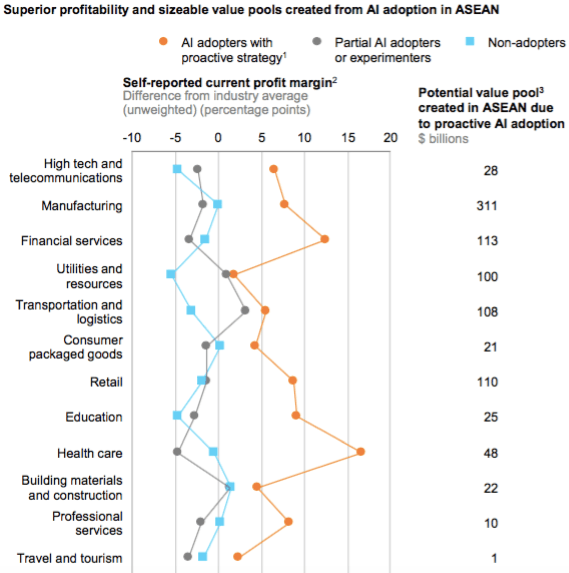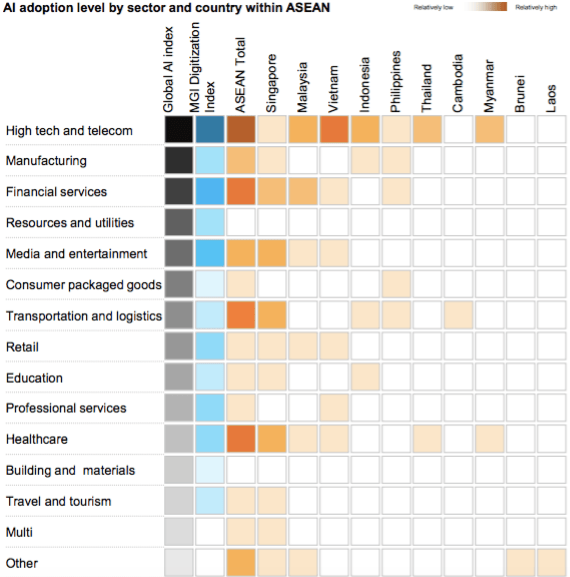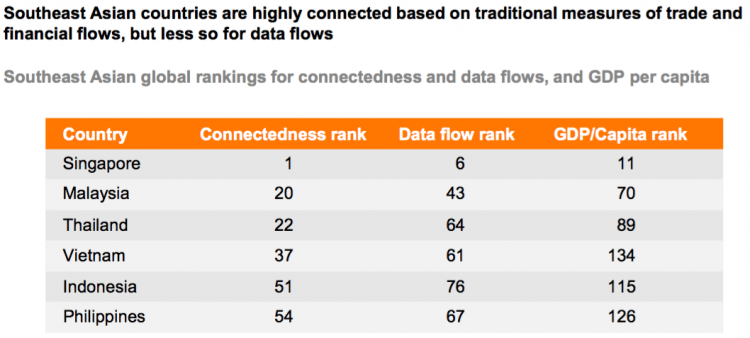
Photo credit: Alex Knight.
Companies in Southeast Asia with a proactive strategy to adopt artificial intelligence (AI) are seeing a significant impact on their businesses, finds a new McKinsey Global Institute study.
The study compares the profit margins of proactive adopters of AI with those of non-adopters, and finds gaps opening up already between them in most sectors. The biggest differences between adopters and non-adopters can be seen so far in high tech and telecom, financial services, manufacturing, retail, healthcare, education, and professional services.

Source: McLinsey Global Institute.
This study released last month analyzes a Southeast Asian subset from a survey of 3,000 companies across the world earlier this year on their adoption of AI. While the survey clearly shows the advantage gained by those adopting AI, the ecosystem for doing this is still quite immature in Southeast Asia compared to the US and China, with several sectors lagging.
Half of all the current AI use cases in Southeast Asia are in high tech and telecom, and financial services.
Half of all the current AI use cases in Southeast Asia are in high tech, telecom, and financial services.
Hong Leong Bank of Malaysia, for example, uses Watson – a cloud-based AI system from IBM – to gauge customers’ emotions by the way they speak on the telephone. Hong Kong-based startup CompareAsiaGroup, which operates in five Southeast Asian countries, is using machine learning to match customers with financial, telecom, and utility services.
The use of virtual assistants to answer customer queries is catching on too. But very few firms in Southeast Asia have scaled up AI use cases such as credit scoring and dynamic pricing which are being developed in the US and China. Banks and startups in the region will have to develop new skills and innovate to benefit from the opportunity. And before that, they need to accelerate digitization of customer interactions because AI tools have to be fed copious amounts of data.
What makes the case for it stronger is that their consumers are by and large digitally savvy, especially in Singapore, Malaysia, and Thailand, which are well-connected online, as well as Indonesia where smartphone usage is rising fast.

Source: McKinsey Global Institute.
Not surprisingly, telecom operators are among the early adopters of AI in the region along with banks and fintech startups. Apart from analytics on customers to minimize churn or cross-sell services, they’re using AI to move into other industries as well.
Singtel has established a subsidiary, DataSpark, for data analytics on shoppers. Indosat’s analytics unit, Eureka, focuses on digital marketing for retailers and credit scoring for banks.
The study also calculates the potential value from AI adoption in each industry. For this, it took the difference in profit margin between the proactive adopters and the non-adopters and multiplied that with the total annual revenue in each sector across the 10 countries which are part of ASEAN (Association of Southeast Asian Nations): Singapore, Indonesia, Malaysia, Thailand, the Philippines, Vietnam, Cambodia, Laos, Brunei, and Myanmar.
By far, the analysis shows that the biggest potential gain in profits from the adoption of AI is in manufacturing – estimated at US$311 billion by extrapolating the gains made by early adopters. Yet, adoption remains lukewarm.
That is because it’s a daunting prospect for companies – especially in non-tech, traditional industries – to make AI a part of their core business. It requires a shift in mindset as well as a complete overhaul of processes in many cases.

Source: McKinsey Global Institute.
McKinsey estimates that smart factories – dubbed the fourth industrial revolution or Industry 4.0 – can boost efficiency by 15 to 20 percent. Global manufacturers, especially those from Germany, have already demonstrated its feasibility and value. Henkel’s “dragon plant” for adhesives in China, for example, uses predictive analytics from IoT sensors for preventive maintenance, optimized use of raw materials, and quality assurance. Hitachi in Japan is tying up with IoT startups to help its customers move to intelligent manufacturing.
See: This IoT startup is competing with GE and winning. Here’s how.
In Southeast Asia, Thai food and beverage conglomerate ThaiBev and Malaysian car manufacturer Proton are pushing ahead with Industry 4.0 technologies in their plants. Governments in Singapore, Malaysia, and Thailand are also supporting the shift to Industry 4.0 in view of the potential impact of productivity gains on economic growth.
But in countries where labor costs are low, manufacturers are reluctant to make the upfront capital investments necessary for digitization. This may change as wages rise, like we’re seeing in China and Taiwan. Foxconn replaced tens of thousands of its employees in its Chinese factories with robots, and started spending aggressively on AI technologies last year.
The biggest hurdle companies face in adopting AI is in finding the right talent. Data scientists are in short supply.
AI adoption is closely linked with digitization which in turn creates the necessary data ecosystem – the collection and aggregation of big data sets that train self-learning algorithms to take actions or draw conclusions without requiring rules-based programming. The practical uses range from optimizing equipment maintenance to fine-tuning prices, providing personalized user experiences, and predicting health needs.
There’s some evidence of digitization picking up pace in Southeast Asia. As the McKinsey report notes, only 6 percent of the region’s large corporations mentioned terms such as “big data”, “advanced analytics”, “AI”, “machine learning”, and the “internet of things” in their 2011 annual reports. By 2016, one-third of them did.
Since the level of digitization determines AI adoption, it’s not surprising that high tech, telecom, and financial services companies are leading the way. But government initiatives and smart city programs have also given a spurt to AI in transportation and health care. Overall, across multiple industries, Singapore takes the lead, followed by Malaysia and Vietnam.
But being well-connected is not the same as having access to data. Here regulators have a role to play in balancing privacy concerns with establishing an open but secure data environment, which is the lifeblood of AI. This is even more of an issue in cross-border data flows across Southeast Asia. “Our analysis shows that ASEAN countries have a high degree of global connectedness … but they are notably less connected in terms of cross- border data flows,” says the McKinsey report.

Source: McKinsey Global Institute.
Large, digitally oriented corporations are best placed to adopt AI and derive competitive advantage. Hence telecom companies in Southeast Asia have made early forays into AI for customer intelligence. But they’re coming up short, notes the McKinsey study, in scaling up. That’s because they lack critical skill sets in data science and adapting it to their business.
Companies in other industries are likely to run into the same barriers. “[They] will require sharper business cases, more robust data ecosystems, and more concerted talent and capability development if AI is to reach its full potential throughout the region,” says the report.
Meanwhile, proactive adopters of AI are passing their gains in profits to customers in efforts to consolidate their position in the market and eliminate competition. “This winner-takes-all dynamic further exacerbates the “digitize or die” scenario that many incumbents find themselves in,” McKinsey’s report notes.
Talent crunch
The biggest hurdle companies face is in finding the right talent. Data scientists – the people who design, deploy, and train AI engines – are in short supply even in Silicon Valley. The shortage is far more acute in Southeast Asia.
In an earlier study, McKinsey had noted that the demand-supply gap is even greater when it comes to “business translators.” These are people who have both data science skills and industry or domain expertise; they can ask the right questions and come up with business use cases. And it’s harder to outsource this function because it often requires access to internal or proprietary knowledge.
See: Why companies suck at data analytics, McKinsey finds out
One way out, suggests the McKinsey report, is to adopt a build-operate-transfer model. This would allow experts from specialist firms to come in and be embedded within project teams of an organization. They would gain operational understanding by collaborating with employees from the host organization. And conversely, the company employees would gain new skills to be able to manage scaling and improvements after the initial deployment.
But even as companies figure out the way forward in adopting AI, governments in the region will need to come up with a policy response that balances economic and social objectives. An earlier report from McKinsey had shown that half the work people do can be automated.
Southeast Asia mirrors that trend in its four biggest economies: Indonesia (52 percent of all activities), Malaysia (51 percent), the Philippines (48 percent) and Thailand (55 percent). These tasks currently generate more than US$900 billion in wages. Companies and governments of the region will have to look at ways to help people develop new skills or compensate them for jobs lost. That will be important for social acceptance of AI.
This post AI haves are pulling ahead of have-nots in profit margins, McKinsey study finds appeared first on Tech in Asia.
from Tech in Asia https://www.techinasia.com/ai-haves-are-pulling-ahead-of-have-nots
via IFTTT
No comments:
Post a Comment